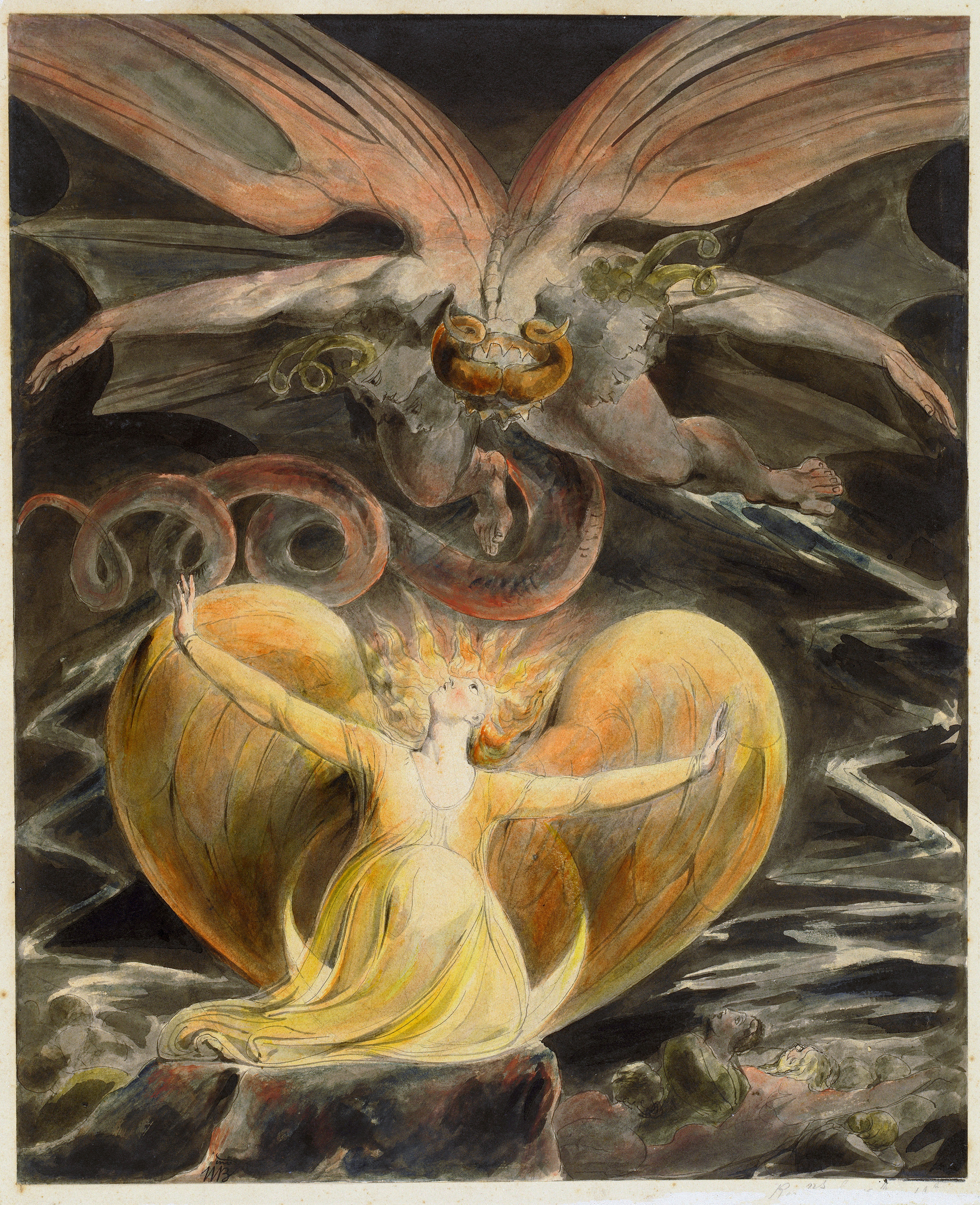Below is a timeline of the emperors of Rome from the birth of Christ through the time John is believed to have written Revelation.
JULIO-CLAUDIAN EMPERORS
27 B.C.-14 A.D. : Augustus
14-37: Tiberius (Christ ascends to heaven here)
37-41: Caligula
41-54: Claudius
54-68: Nero
68-69: Galba [3]
69: Otho
69: Vitellius
FLAVIAN EMPERORS
69-79: Vespasian (The temple is destroyed here-70 A.D.)
79-81: Titus
81-96: Domitian (John writes Revelation here)
96-98: Nerva
98-117: Trajan

The Great Red Dragon and the Woman Clothed with the Sun
by William Blake
v. 1: This woman gives birth to a son, “who is to rule all the nations with a rod of iron.” This is a Messianic reference taken from Psalm 2:9 and clearly applied to Christ in 2:27 and 19:15. The woman, therefore, can only be one of two candidates: Mary or an allegory of the kingdom of Israel. Both of these gave birth to Christ. Many of the early church fathers (including Oecumenius) believed she is Mary, but she may also be an allegory of the kingdom of Israel. For one thing, the crown of twelve stars (representing the twelve tribes of Israel) seems more applicable to an allegory of Israel than to Mary. Another reason for believing she is Israel is rooted in the fact that the events surrounding the woman later in the chapter are more easily applied to Israel (Spiritual Israel) than to Mary. Perhaps Mary herself should be considered a type of Spiritual Israel.
v. 2: Israel gave birth to the Messiah. The birth pangs here might be a reflection of the pain Israel felt under Roman occupation at the time of her deliverance.
v. 4: The second chapter of Matthew records at least one way that Satan tried to kill the baby Jesus.
v. 6: I do not think she fled to the wilderness before the war in heaven. I think the narrative mentions her safe flight to the wilderness at this point to continue the theme of safety begun in v. 5, thus communicating the fact that both she and her son were given secure refuge from the Dragon. For the actual order of events, see v. 13 where it says that the Dragon attacked the woman after he lost the war in heaven.
There is a logical sequence of events here:
1) Satan falls from heaven.
2) He attacks the Church in the hope of destroying it.
3) The woman (i.e., the Church) escapes to the wilderness.
4) Satan knows that he cannot destroy the Church as such, but he continues making war on Christians out of bitterness and wrath.
5) To help him in this, he raises Beast I from the dead.[4]
Therefore, Beast I must come to power and reign at the beginning of the 3½ years that the Church is kept safe in the wilderness.
v. 7: This war is sparked by Christ’s victory on earth and his ascension into heaven to sit on his father’s throne. It is this event that marks the beginning of the final age on earth; perhaps we should count time from it rather than Christ’s birth.
—————-
[3] The tenure of these three emperors was so short that they do not even come into some lists of the emperors, so perhaps one would be justified in ignoring them altogether in John’s count of emperors. They all ruled within a single year during which Rome was enmeshed in civil war. They established no dynasty. The ruling dynasties of Rome began with the Julio-Claudians, followed by the Flavians
[4] Perhaps Beast I had been instrumental in Satan’s former persecutions (when he had had the hope of destroying the Church) but had been slain.




Notes on the Book of Revelation: Chapter 12, Part 3
Posted by lehunt on March 4, 2018
A remorseful Satan, from Gustave Doré’s illustrations for Milton’s Paradise Lost.
v. 9: In a metaphorical sense, it is true that the kingdom of heaven is in our hearts (Luke 17:21), and that if our hearts are wicked, every place is hell (as with Milton’s Satan), but it is literally true that heaven is a place (in as much as we can understand its nature) just as earth is a place. One can be kicked out of it, as with Satan, or one can choose to leave it, (Philippians 2:6-7) come to earth, and return to it (Acts 1:9-11) as Christ did. Although Satan used to make frequent trips to earth before the time of Christ (Job 1:7), he now lives on earth because he has been kicked out of heaven, hence the angel’s words: “[W]oe to the earth and the sea, for the devil has come down to you with great wrath” (12:12).
There is just not enough material in the Bible to put together a really convincing story about Satan’s history, but here is my best attempt. Satan is one of the angels of heaven to whom God gave a considerable amount of power and authority. He had already declared himself the enemy of God and turned to evil by the time of Adam and Eve, but he still seems to have had a place in heaven. In the first chapter of the book of Job, when the angels of God gather in heaven, Satan appears with them, and God does not ask him what he is doing there but rather where he has been (as if Satan were late, or as if God were expecting an official report from him). Perhaps God was tolerating his presence in heaven as he tolerates wicked rulers on earth for a time. Nevertheless, the coming of Christ to earth sounded the death knell for Satan; therefore, he tried to destroy Christ but to no avail. Then, when Christ ascended to the throne of God, Michael led a great war and cast Satan out of heaven.
Speaking of Milton, if the brief history above is correct, Satan rebelled against God but was not kicked out of heaven before the fall of humanity (as he is in Paradise Lost), but rather he was kicked out after Christ’s ascension to the throne of God.
v. 12: The voice in heaven says, “[W]oe to the earth and the sea….” Notice that Beast I rises from the sea (13:1) and that Beast II rises from the earth (13:11).
v. 13: Satan tried to destroy the Church itself soon after his forced exile from heaven. Historically, I would expect this to mean that there was a severe persecution of the Church relatively soon after Christ’s resurrection.
v. 15: The refuge in the wilderness seems like a place of absolute safety, a place where Satan could no longer threaten the woman, but in v. 16 the earth has to step in and save her from Satan’s river. Therefore, I do not believe she has yet flown to the wilderness when Satan tries to drown her.
v. 17: Satan gives up on the idea of destroying the Church as such, and turns instead to persecuting the individual members of the Church, “the rest of her children.” The first of her children is Christ (Romans 8:29). Perhaps his method of persecuting them was to resurrect Beast I. Historically, I would expect that this might not look any different than when Satan was trying to destroy the Church. In other words, in both instances Christians were persecuted. However, on the former occasion, the persecution was fueled by hatred of Christ and the hope of extinguishing his Church, whereas on the latter occasion the persecution was fueled only by hatred of Christ.
Posted in New Testament, revelation | Tagged: commentary on Revelation 12, Gustave Doré, John Milton, Larry Hunt Bible Commentary, Online Bible commentary, Paradise Lost, When did Satan fall from heaven? | Leave a Comment »